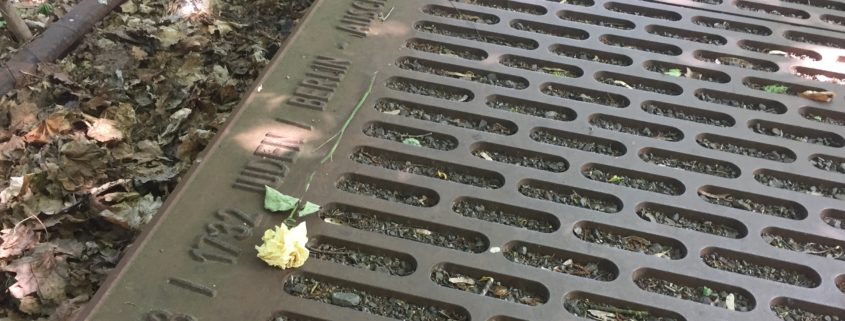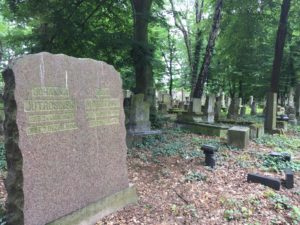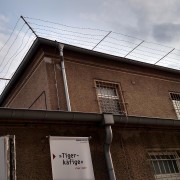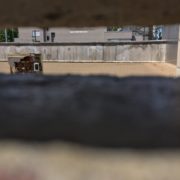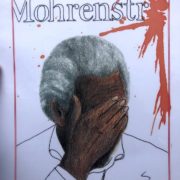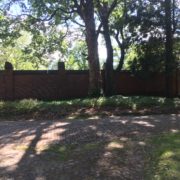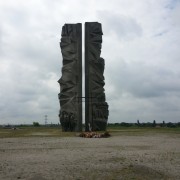My Work in the Service Learning Project and Why it’s Such a Meaningful Opportunity
By Eric Weisansal
Many of the historical sites we have visited throughout our time in Europe have each contributed individually to how meaningful our experience at New Jewish cemetery was. We have learned so much about the history of Germany and Poland, so we are able to recognize that the work we have done in the cemetery to restore the memory of the former Jewish people, who resided in what was then called Breslau has extreme importance. Many of the German and Jewish cemeteries in the Wroclaw area have been destroyed and completely forgotten. Because of this destruction, it seems as if a part of this area’s history is being forgotten, and it’s an extremely important part of not only Polish and German history, but also a part world history. Learning the history in greater depth, like we have been doing throughout the past two weeks in order to really understand all the devastation and loss that came along with the Second World War, is what makes the work at the cemetery so meaningful.
There are certain parts of this study abroad that specifically made the work most meaningful to me. The one that stood out the most to was our visit to the Track 17 memorial in Berlin. Track 17 is a spot that millions of the Jewish people were deported to concentration camps throughout Poland, many of which were lied to and said they were just being re-located to the East and some were even forced to buy tickets for these trains. This memorial is appears to be little known to the people of Berlin. Josefine, one of our teachers from our time in Berlin, said that she discovered the memorial only accidentally. Which is extremely surprising because she is an education major and I believe history as well, so if Josefine had only accidentally stumbled upon it I truly believe that a majority of Berliners do not know of the memorial. How could a spot that directly relates to the Nazi regime and to the deaths of millions of Jewish people be so easily forgotten? And if that could be forgotten by the people, it unfortunately must be even easier to forget a little cemetery from pre-war. This reasoning allows for our work to be important to me and even if other people may not know of our work, I know that what we’re doing is important for the world.
The entrance to the New Jewish Cemetery is riddled with bullet holes, which indicates exactly how lucky we are that it survived the war, also taking in consideration postwar anti-Semitism, which led to the emigration of the majority of Poland’s Jewish populations. The damage continues inside the walls of the cemetery as well, with a large amount of the tomb stones having been destroyed, removed, or are just completely illegible. Many of the cemetery archives have been destroyed as well, which brings me to our work. What I, and Study Abroad classmates have been doing is we each have gotten in our smaller groups of three or four and separated into our fields; we received Field 15, but only part of it as it’s such a big field it has been split into A and B. Our job is mapping the field, so that it’s actually possible to find a certain tombstone or place where a tombstone once was, try to mark any names down from the stones, and tell if the stone is preserved or not. Although the sight of all these tombstones being destroyed and degraded is such a sad thing to see, the work that we’ve accomplished makes me happy for a few reasons. The first is that I know that I’m helping to reverse the damage that has been done and which should have never been done in the first place. The second reason for my sense of satisfaction is that on the last day of our work at the cemetery, on June 12, 2017, large group of people, all working on improving the cemetery and to fix this wrongdoing. On that day, there were many Polish and German students and volunteers helping to do everything from clean up the greenery, record information on gravestones or undertaking any type of work that was needed.The sight of all those people working at the cemetery was gratifying. The third reason that I am happy is that we’re working for a group which throughout the 20th century has had an extreme population loss in Europe and especially in that area. Wroclaw, the location of the cemetery, once had a large Jewish population until after World War Two, both in the German Breslau, when Jews were killed under Nazi regime and after the war due to the anti-Semitic campaigns by the communist government in Poland.
I am extremely honored to be a part of the revitalization of the cemetery and the restoration of a people’s history. I have never done anything like this project before, working on something which has such historical meaning and value that will hopefully be there for the rest of history as well. It was really good feeling to a part of this project and I hope one day I can do something similar. I give great credit to the man in charge of the whole project, Piotr, who has been working at the cemetery for ten years now. When Piotr showed us the field which we would be working on, he called it the “Ambitious Field,” which I thought was a good fit because I knew I was ambitious to help restore this history in the greatest way possible. I was very lucky to be able to help Piotr. I hope that my part in this project helps him significantly. Piotr has exhibited such impressive dedication to the cemetery and I know that with him in charge, the cemetery will be safe for many, many years to come and will only improve throughout those years.

